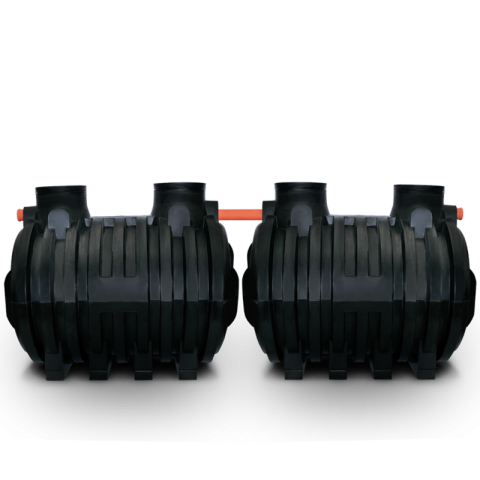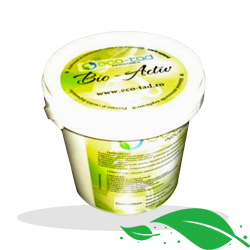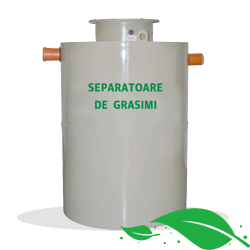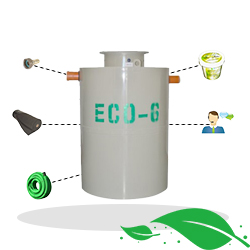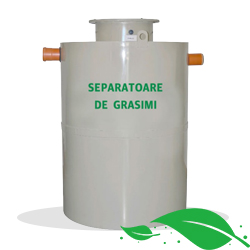

ECODIS80 GREASE SEPARATOR
Cod produs: ECOdis80
10000 lei
Descriere produs
Grease and heavy particle separators (degreasing devices) are used to remove non-emulsified fats from wastewater (grey water from bathrooms, sinks, kitchens when they have separate sewerage). In the presence of oil, in the case of a deficient treatment system, foams, fats (low-weight substances) and heavy particles (high specific-weight substances) cause sludge compaction, which clogs the sewer system or reduce the performance of the treatment unit.
Grease separators are chosen according to the number of users, given that the European regulations consider that the consumption of water in a private home is 30 L/day/user and in a public food unit is 50 L/day/user. Choosing larger volume does not compromise the operation of the separator, but will allow the user to engage in extraction operations more rarely.
THE OPERATING PRINCIPLE OF GREASE SEPARATORS
The operating principle is based on the use of a stilling vessel where it is possible to separate foams, floating fats and heavy particles from wastewater through flotation, based on the liquid-liquid or solid-solid gravity separation laws.
DESCRIPTION OF THE FUNCTIONING PROCESS
Wastewater enters through the fermentation tank where, under the action of anaerobic bacteria and based on the liquid-liquid/liquid-solid gravity separation laws, decomposition and separation of light and sedimentary matter occur. Following this separation process the polluting sludge is deposited through the discharge slot into the sedimentation area, from where it is removed after a period by emptying. The resulting treated water is discharged through communicating vessels into absorbing wells or underground drains, from where they will be taken over by the capillary vessels of the soil that will continue to act as a biological filter.
The advantages of this solution are that the volume of waste that is emptied is very small, compared to the corresponding volume of the sedimentary deposit, because, through the action of anaerobic bacteria, it mineralises and loses its water content. After the fermentation processes, biogas is formed, which is evacuated into the atmosphere through the special hole created for it.
INSTALLATION OF THE GREASE SEPARATOR
The location of the grease separators must comply with the following requirements and conditions:
- to ensure as much as possible the flow of water through gravity in all areas of the grease separator
- to be located outside the property at least 1 meter from the foundation and at least 10 meters from any drinking water well or tank
- to ensure easy access for emptying
- it is recommended to build protective walls for areas at risk of flooding
- it is recommended to perform assessments of the soil permeability coefficient called “percolation tests”
BURYING RULES
The installation of TELCOM grease separators is performed by burying with or without a protective structure. These methods depend on the soil structure and the depth at which the separators will be mounted. Irrespective of the burial method, a pit must be dug, 30cm larger than the main tank.
Burying without protective structure
If soil structure allows, Telcom grease separators will be buried completely in the ground. Being fitted with a biogas evacuation outlet, a tube will be installed to ensure the release of biogas into the atmosphere.
ATTENTION! In case of burial without protective structure, Telcom grease separators can be covered with a layer of soil with a maximum thickness of 30 cm
Burying with protective structure
If the TELCOM grease separators are installed in areas with muddy land or where the groundwater reaches the surface, with the possibility of being flooded, it is necessary to protect the products with a monolithic concrete structure.
Irrespective of the method chosen, a pedestrian passage area will result above the pit
To ensure the passage of heavy traffic, it is necessary to consult a specialist engineer.
APPLICATION
The main source of vegetable fats and oils is found in the food industry:
- butcheries, sausage and meat preparation factories
- slaughterhouses
- fish preparation units
- walnut/hazelnut roasting units
- oil, butter, margarine producers
- cafeterias located in administrative, commercial, social-cultural buildings, hospitals, hotels
- military units
- restaurants, fast-foods
- soap and stearin factories
PRODUCT ADVANTAGES
- small
- tightly closed
- does not occupy space (must be buried)
- low weight
- does not require power supply
- neutrally reactive to UV radiation
- resistance to chemical attack and corrosion
- does not require maintenance, just emptying
- the tank shape has the advantage of a solid monolithic structure
- mechanical and thermal resistance at temperatures between -60 and +80 degrees Celsius
- complies with European standards guaranteeing a 100% recyclable product
PERFORMANCES
Through wastewater treatment, grease separators provide the following:
- removal of the organic sludge component up to 50%
- removal of sediments to up to 90%
FAQ
1. When is the bacterial culture added to the treatment plant?
Answer: The bacterial culture (biological activator) is added before the first use of the treatment plant. It has the role of accelerating the formation of bacterial culture.
2. What the P.E. abbreviation stands for?
Answer: P.E. is a unit of measure called population equivalent. According to CE 12566/3, the flow is calculated taking into account the average consumption per person, of about 200 L/day. For example, an ECO IMO 6 septic tank is d for 6 P.E., so its maximum capacity is calculated according to the formula 6 P.E. x 200 L/day = 1,200 L of domestic water/day.
PRODUCT MARKINGS
The following markings appear on the product:
- Date and year of manufacture of the grease separator
- The “RECYCLABLE PRODUCT” symbol indicating compliance with European standards guaranteeing a 100% recyclable product that protects and defends the environment
| Grease separator | |
| Number of users | 111 |
| Number of dining seats | 333 |
| Min. separation area (m2) | 6,25 |
| Flow rate (L/s) | 24,77 |
| Dimensions (mm) | |
| Vat height | 2100 |
| Overall height | 2300 |
| Length | 1800 |
| Inlet height | 2000 |
| Outlet height | 1950 |
| Inspection cover (Øxh) | 500x200 |
| Øi / Øe | 110 |
| Biogas (Ø) | 1” |
| Volume (litres) | |
| Useful | 5080 |
| Total | 5340 |
Nici un comentariu pentru acest produs. Fii primul!
Adaugă un review
